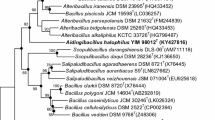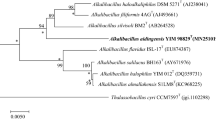Abstract
A Gram-positive, rod-shaped, strictly aerobic bacterium, strain WSY08-1T, was isolated from a salt mine in Wensu county, Xinjiang province, China. Spherical to ellipsoidal endospores were observed to be formed in terminal swollen sporangia. Strain WSY08-1T was found to be able to grow at 20–45 °C (optimum 37 °C), 0–10 % (w/v) NaCl (optimum 4 %, w/v) and pH 6.0–9.0 (optimum 7.0). Catalase and oxidase activities were observed to be positive. The cell-wall peptidoglycan of strain WSY08-1T was found to contain meso-diaminopimelic acid. Menaquinone-7 (MK-7) was identified as the predominant isoprenoid quinone. The polar lipids were found to consist of phosphatidylglycerol, diphosphatidylglycerol, an unknown glycolipid, two unknown phospholipids and an unknown lipid. The major cellular fatty acids were identified as anteiso-C15:0 and anteiso-C17:0. The DNA G+C content was determined to be 36.9 mol%. Analysis of the 16S rRNA gene sequence showed that strain WSY08-1T is closely related to Aquibacillus halophilus B6BT, Aquibacillus koreensis BH30097T and Aquibacillus albus YIM 93642T (97.6, 96.9 and 96.5 % similarity, respectively). The level of DNA–DNA relatedness between strains WSY08-1T and A. halophilus B6BT was 31.4 %. On the basis of its phenotypic, chemotaxonomic and genotypic characteristics, strain WSY08-1T is considered to represent a novel species in the genus Aquibacillus, for which the name Aquibacillus salifodinae sp. nov. is proposed. The type strain is WSY08-1T (=JCM 19761T = CGMCC 1.12849T).

Similar content being viewed by others
References
Amoozegar MA, Bagheri M, Didari M, Mehrshad M, Schumann P, Spröer C, Sánchez-Porro C, Ventosa A (2014) Aquibacillus halophilus gen. nov., sp. nov., a moderately halophilic bacterium from a hypersaline lake, and reclassification of Virgibacillus koreensis as Aquibacillus koreensis comb. nov. and Virgibacillus albus as Aquibacillus albus comb. nov. Int J Syst Evol Microbiol 64:3616–3623
De Ley J, Cattoir H, Reynaerts A (1970) The quantitative measurement of DNA hybridization from renaturation rates. Eur J Biochem 12:133–142
Dong XZ, Cai MY (2001) Determination of biochemical properties. In: Dong XZ, Cai MY (eds) Manual for the systematic identification of General Bacteria. Science Press, Beijing, pp 370–398 in Chinese
Dussault HP (1955) An improved technique for staining red halophilic bacteria. J Bacteriol 70:484–485
Felsenstein J (1981) Evolutionary trees from DNA sequences: a maximum likelihood approach. J Mol Evol 17:368–376
Fitch WM (1971) Toward defining the course of evolution: minimum change for a specific tree topology. Syst Zool 20:406–416
Grishchenkov VG, Townsend RT, McDonald TJ, Autenrieth RL, Bonner JS, Boronin AM (2000) Degradation of petroleum hydrocarbons by facultative anaerobic bacteria under aerobic and anaerobic conditions. Process Biochem 35:889–896
Gutiérrez C, González C (1972) Method for simultaneous detection of proteinase and esterase activities in extremely halophilic bacteria. Appl Microbiol 24:516–517
Huo YY, Xu XW, Cui HL, Wu M (2010) Gracilibacillus ureilyticus sp. nov., a halotolerant bacterium from a saline-alkaline soil. Int J Syst Evol Microbiol 60:1383–1386
Huß VAR, Festl H, Schleifer KH (1983) Studies on the spectrophotometric determination of DNA hybridization from renaturation rates. Syst Appl Microbiol 4:184–192
Kim OS, Cho YJ, Lee K, Yoon SH, Kim M, Na H, Park SC, Jeon YS, Lee JH, Yi H, Won S, Chun J (2012) Introducing EzTaxon-e: a prokaryotic 16S rRNA Gene sequence database with phylotypes that represent uncultured species. Int J Syst Evol Microbiol 62:716–721
Kimura M (1980) A simple method for estimating evolutionary rates of base substitutions through comparative studies of nucleotide sequences. J Mol Evol 16:111–120
Komagata K, Suzuki K (1987) Lipid and cell-wall analysis in bacterial systematics. Method Microbiol 19:161–207
Kuykendall LD, Roy MA, O’Neill JJ, Devine TE (1988) Fatty acids, antibiotic resistance, and deoxyribonucleic acid homology groups of Bradyrhizobium japonicum. Int J Syst Bacteriol 38:358–361
Lee JS, Lim JM, Lee KC, Lee JC, Park YH, Kim CJ (2006) Virgibacillus koreensis sp. nov., a novel bacterium from a salt field, and transfer of Virgibacillus picturae to the genus Oceanobacillus as Oceanobacillus picturae comb. nov. with emended descriptions. Int J Syst Evol Microbiol 56:251–257
Logan JM, Berge O, Bishop AH, Busse HJ, De Vos P, Fritze D, Heyndrickx M, Kämpfer P, Rabinovitch L, Salkinoja-Salonen MS, Seldin L, Ventosa A (2009) Proposed minimal standards for describing new taxa of aerobic, endospore-forming bacteria. Int J Syst Evol Microbiol 59:2114–2121
Mesbah M, Whitman WB (1989) Measurement of deoxyguanosine/thymidine ratios in complex mixtures by high-performance liquid chromatography for determination of the mole percentage guanine + cytosine of DNA. J Chromatogr 479:297–306
Minnikin DE, Odonnell AG, Goodfellow M, Alderson G, Athalye M, Schaal A, Parlett JH (1984) An integrated procedure for the extraction of bacterial isoprenoid quinones and polar lipids. J Microbiol Method 2:233–241
Saitou N, Nei M (1987) The neighbor-joining method: a new method for reconstructing phylogenetic trees. Mol Biol Evol 4:406–425
Skerman VBD (1967) A guide to the identification of the genera of bacteria, 2nd edn. Williams & Wilkins, Baltimore
Tamura K, Peterson D, Peterson N, Stecher G, Nei M, Kumar S (2011) MEGA5: molecular evolutionary genetics analysis using maximum likelihood, evolutionary distance, and maximum parsimony methods. Mol Biol Evol. doi:10.1093/molbev/msr121
Thompson JD, Higgins DG, Gibson TJ (1994) CLUSTAL W: improving the sensitivity of progressive multiple sequence alignment through sequence weighting, position-specific gap penalties and weight matrix choice. Nucleic Acids Res 22:4673–4680
Xu XW, Wu YH, Zhou Z, Wang CS, Zhou YG, Zhang HB, Wang Y, Wu M (2007) Halomonas saccharevitans sp. nov., Halomonas arcis sp. nov., and Halomonas subterranea sp. nov., halophilic bacteria isolated from hypersaline environments of China. Int J Syst Evol Microbiol 57:1619–1624
Zhang YJ, Zhou Y, Ja M, Shi R, Chun-Yu WX, Yang LL, Tang SK, Li WJ (2012) Virgibacillus albus sp. nov., a novel moderately halophilic bacterium isolated from Lop Nur salt lake in Xinjiang province, China. Antonie van Leeuwenhoek 102:553–560
Zhang WY, Fang MX, Zhang WW, Xiao C, Zhang XQ, Yu ZP, Zhu XF, Wu M (2013) Extensimonas vulgaris gen. nov., sp. nov., a novel member of the family Comamonadaceae. Int J Syst Evol Microbiol 63:2062–2068
Zhu XF (2011) Modern experimental technique of microbiology. Zhejiang University Press, Hangzhou English translation
Acknowledgments
This work was supported by grants from the National Natural Science Foundation of China (No. 31170001).
Author information
Authors and Affiliations
Corresponding author
Electronic supplementary material
Below is the link to the electronic supplementary material.
Rights and permissions
About this article
Cite this article
Zhang, WY., Hu, J., Zhang, XQ. et al. Aquibacillus salifodinae sp. nov., a novel bacterium isolated from a salt mine in Xinjiang province, China. Antonie van Leeuwenhoek 107, 367–374 (2015). https://doi.org/10.1007/s10482-014-0335-9
Received:
Accepted:
Published:
Issue Date:
DOI: https://doi.org/10.1007/s10482-014-0335-9




